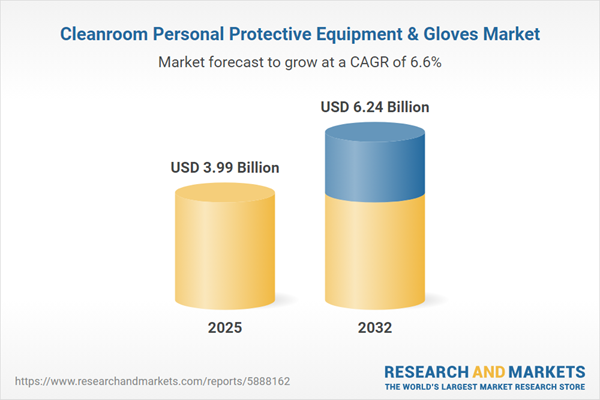Speak directly to the analyst to clarify any post sales queries you may have.
In an environment shaped by fast-changing regulations and ongoing demands for contamination control, the cleanroom personal protective equipment and gloves market is evolving rapidly. Senior leaders seeking actionable insights can leverage this research to strengthen decision-making and operational strategies amidst sector transformation.
Market Snapshot: Cleanroom Personal Protective Equipment & Gloves Market
The cleanroom personal protective equipment and gloves market is experiencing robust, steady growth, fueled by intensifying calls for contamination control across pharmaceutical, biotechnology, and advanced manufacturing. Notable advances include the introduction of improved glove materials and ergonomically engineered garment designs, both focused on providing enhanced protection and wearer comfort. Major suppliers are increasingly bundling monitoring solutions with their product offerings to help companies meet shifting compliance requirements and broaden their reach within regulated sectors. Leading industry participants are not only updating product lines, but also actively incorporating flexible procurement models and advanced technologies, driving fundamental changes in expectations for cleanroom PPE. As regulatory frameworks evolve, the market is adjusting with new operational models, investments in innovation, and strategic approaches to competitive differentiation.
Scope & Segmentation
This report delivers a comprehensive exploration of the cleanroom PPE and gloves market, guiding decision-makers through critical segmentation dimensions and how they enable technology integration, procurement, and competitive positioning:
- Product Categories: Caps, helmets, coveralls, face masks, hoods, overboots, and various glove types including latex, neoprene, nitrile, and polyisoprene—all developed for specialized contamination control protocols.
- End-Use Industries: Biologics manufacturing, semiconductor and electronics fabrication, healthcare, medical device assembly, pharmaceutical production, and retail pharmacy operations, each sector with unique compliance challenges and environmental requirements.
- Distribution Channels: Blend of offline and online procurement options, from high-volume commodity supplies to customized solutions for highly regulated environments, enabling versatility and targeted purchasing.
- Geographic Regions: Americas, Europe, Middle East, Africa, and Asia-Pacific, each region shaped by localized regulations and distinct trends in PPE adoption.
- Key Companies: Leading suppliers include Top Glove Corporation Berhad, Ansell Limited, Hartalega Holdings Berhad, Kossan Rubber Industries Berhad, Supermax Corporation Berhad, Semperit AG Holding, Sri Trang Agro-Industry Public Company Limited, DuPont de Nemours Inc., 3M Company, and Kimberly-Clark Corporation.
This segmentation structure enables organizations to compare innovation opportunities, monitor emerging technology adoption, and align strategies with region- and sector-specific risk and compliance drivers.
Key Takeaways for Senior Decision-Makers
- Stricter requirements for traceability and transparency are establishing more rigorous compliance frameworks, with direct implications for regulated industries.
- The use of advanced and ergonomic glove shapes, as well as high-performance barrier materials, is raising workforce safety and efficiency in controlled environments.
- Transitioning toward recyclable and biodegradable PPE solutions addresses sustainability concerns and supports alignment with future-oriented regulations across global regions.
- Adoption of harmonized global standards streamlines procurement and ensures consistency, but also necessitates agile and validated supply chain partnerships.
- Enhanced and responsive procurement strategies are emerging as critical tools for building resilience, especially as companies adjust to fluctuating regulatory demands and varying regional dynamics.
Senior executives are encouraged to incorporate these evolving trends within procurement and vendor management for robust compliance and operational agility.
Tariff Impact and Supply Chain Adjustments
The report reviews recent U.S. tariff policies influencing the sourcing landscape for cleanroom PPE and gloves, particularly around specialty textiles and chemical ingredients. To mitigate elevated supply chain risks and manage costs, organizations are increasing domestic manufacturing and expanding partnerships with nearshore suppliers. Facility management and equipment providers are working closely to maintain compliance amid shifting global certification standards and trade regulations, ensuring continuous adaptability and minimized disruption.
Research Methodology & Data Sources
The report’s findings are founded on direct executive interviews with leading manufacturers, distributors, and end users. This primary research is complemented by peer-reviewed literature and regulatory data, along with input from recognized industry associations. The combination of qualitative and quantitative insights contributes to the accuracy and sector relevance of the analysis.
Why This Report Matters
- Equips senior management with segmented, actionable insights to track regulatory trends and implement the latest contamination control strategies.
- Clarifies investment decisions and procurement approaches by detailing the influence of sustainability goals and supply chain innovation in the cleanroom PPE and gloves market.
- Supports risk management and growth initiatives with up-to-date intelligence for navigating complex regulatory and operational environments.
Conclusion
Operational adaptability and strategic foresight are vital for success in the cleanroom PPE and glove industry. This report provides senior leaders with the actionable intelligence needed to anticipate sector changes and plan resilient, forward-looking strategies.
Additional Product Information:
- Purchase of this report includes 1 year online access with quarterly updates.
- This report can be updated on request. Please contact our Customer Experience team using the Ask a Question widget on our website.
Table of Contents
3. Executive Summary
4. Market Overview
7. Cumulative Impact of Artificial Intelligence 2025
Samples

LOADING...
Companies Mentioned
The key companies profiled in this Cleanroom Personal Protective Equipment & Gloves market report include:- Top Glove Corporation Berhad
- Ansell Limited
- Hartalega Holdings Berhad
- Kossan Rubber Industries Berhad
- Supermax Corporation Berhad
- Semperit AG Holding
- Sri Trang Agro-Industry Public Company Limited
- DuPont de Nemours, Inc.
- 3M Company
- Kimberly-Clark Corporation
Table Information
| Report Attribute | Details |
|---|---|
| No. of Pages | 195 |
| Published | October 2025 |
| Forecast Period | 2025 - 2032 |
| Estimated Market Value ( USD | $ 3.99 Billion |
| Forecasted Market Value ( USD | $ 6.24 Billion |
| Compound Annual Growth Rate | 6.5% |
| Regions Covered | Global |
| No. of Companies Mentioned | 10 |









